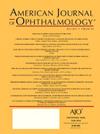Posterior Eye Curvature as a Biomarker for Differentiating Pathologic Myopia From High Myopia
IF 4.1
1区 医学
Q1 OPHTHALMOLOGY
引用次数: 0
Abstract
PURPOSE
To characterize posterior eye curvature and to assess its diagnostic performance in differentiating pathologic myopia (PM) from simple high myopia (SHM).
DESIGN
Population-based, cross-sectional study.
PARTICIPANTS
A total of 790 eyes from 790 participants (mean age: 60.6 ± 8.3 years; 59% female) were randomly selected from the Beijing Eye Study, including 406 nonmyopic eyes, 175 eyes with mild myopia, 102 eyes with moderate myopia, 76 eyes with simple SHM, and 31 eyes with PM.
METHODS
Posterior eye curvature was calculated using the outer boundary of the retinal pigment epithelium layer, derived from automatically segmented spectral-domain optical coherence tomography images. Three curvature parameters were computed: curvaturemean, curvaturemax and curvaturemacula.
MAIN OUTCOME MEASURES
The values and spatial distribution of curvature parameters across different myopia groups, and their diagnostic performance in distinguishing PM from SHM.
RESULTS
Higher curvature parameters were significantly associated with older age, longer axial length (AL), more myopic refractive error (RE), lower best-corrected visual activity, and smaller subfoveal choroidal thickness (all P < .001). These parameters increased progressively with myopia severity (all P < .001). Unlike traditional metrics such as AL, which demonstrated a steady increase across the entire spectrum of myopia, curvature parameters showed a significantly sharper increase between SHM and PM, compared to other pairwise comparisons (nonmyopia vs mild myopia, mild vs moderate myopia, and moderate myopia vs SHM) (all P < .001). After adjusting for age, AL, and RE, the curvature parameters remained significantly associated with the occurrence of PM (all P ≤ .003). In distinguishing PM from SHM, curvaturemax achieved the highest diagnostic performance, with an area under the receiver operating characteristic curve (AUROC) of 0.92 (95% CI, 0.87-0.98), followed by 0.86 (95% CI, 0.78-0.94) for curvaturemean, 0.84 (95% CI, 0.76-0.93) for curvaturemacula, 0.75 (95% CI, 0.62-0.89) for AL, and 0.76 (95% CI, 0.66-0.86) for RE. The performance of curvaturemax was significantly higher than AL (P = .020) and RE (P = .006).
CONCLUSIONS
Posterior eye curvature increased with myopia severity and outperformed traditional AL and RE, suggesting its potential as a desirable biomarker in differentiating PM from SHM. Further research, particularly longitudinal studies, is warranted to evaluate whether the curvature can predict myopia prognosis and the development of pathologic changes.
求助全文
约1分钟内获得全文
求助全文
来源期刊
CiteScore
9.20
自引率
7.10%
发文量
406
审稿时长
36 days
期刊介绍:
The American Journal of Ophthalmology is a peer-reviewed, scientific publication that welcomes the submission of original, previously unpublished manuscripts directed to ophthalmologists and visual science specialists describing clinical investigations, clinical observations, and clinically relevant laboratory investigations. Published monthly since 1884, the full text of the American Journal of Ophthalmology and supplementary material are also presented online at www.AJO.com and on ScienceDirect.
The American Journal of Ophthalmology publishes Full-Length Articles, Perspectives, Editorials, Correspondences, Books Reports and Announcements. Brief Reports and Case Reports are no longer published. We recommend submitting Brief Reports and Case Reports to our companion publication, the American Journal of Ophthalmology Case Reports.
Manuscripts are accepted with the understanding that they have not been and will not be published elsewhere substantially in any format, and that there are no ethical problems with the content or data collection. Authors may be requested to produce the data upon which the manuscript is based and to answer expeditiously any questions about the manuscript or its authors.

 求助内容:
求助内容: 应助结果提醒方式:
应助结果提醒方式:


